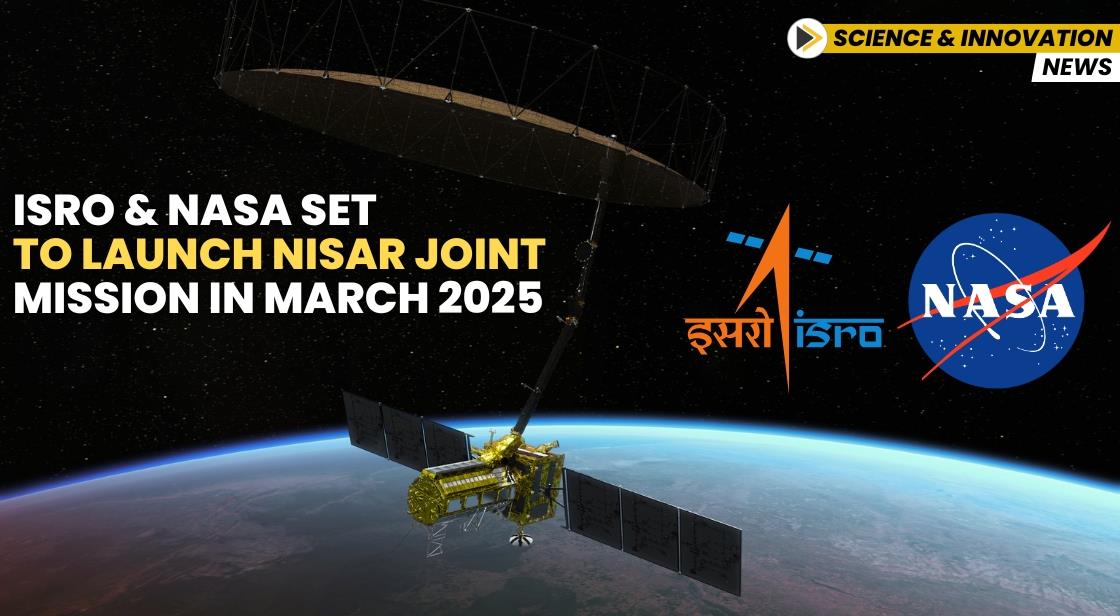ISRO and NASA Set to Launch NISAR Joint Mission in March 2025

News Synopsis
The American space agency NASA and the Indian Space Research Organisation (ISRO) are gearing up to launch the NASA-ISRO Synthetic Aperture Radar (NISAR) satellite in March 2025. This collaboration underscores the strength of international partnerships in space exploration.
Mission Overview: Transforming Earth Observation
Valued at ₹5,000 crore, the NISAR mission is designed to revolutionize global Earth observation. It represents a significant milestone in international space cooperation and aims to provide unprecedented insights into planetary changes and environmental dynamics.
The Journey of NISAR: A Concept Born in 2009
Conceived in 2009, NISAR is a 2.8-tonne satellite engineered to monitor Earth with unmatched precision. It will scan nearly all of the planet’s land and ice surfaces every 12 days, capturing intricate details of ecosystems, land dynamics, and ice formations.
Advanced Technology: What Sets NISAR Apart
NISAR leverages Synthetic Aperture Radar (SAR) technology, offering advanced imaging capabilities. Unlike traditional satellites, SAR uses radio signals to generate high-resolution images, functioning effectively in darkness, adverse weather, and even dense vegetation.
Key Features: Precision and Dual-Frequency Radar
Equipped with dual-frequency radar, NASA's L-band (1.25 GHz) and ISRO's S-band (3.20 GHz), NISAR delivers unparalleled accuracy. It can detect surface changes as small as one inch, making it a game-changer for scientific research and mapping.
Launch and Orbit: Details of Deployment
The satellite will be launched aboard ISRO's GSLV Mk-II rocket from the Satish Dhawan Space Centre. It will operate in a sun-synchronous orbit at an altitude of 747 km and is expected to function for three years.
Applications: Wide-Ranging Scientific Benefits
NISAR’s data will have diverse applications, including studying ecosystem changes, ice dynamics, and geological events like earthquakes, landslides, and volcanic activities. The observations will also enhance understanding of solid Earth movements and their implications.
Overcoming Challenges: Delays and Resolutions
The mission faced delays due to technical complexities, particularly with its 12-meter radar antenna reflector. NASA resolved these issues by applying reflective tape to mitigate temperature-related concerns, ensuring the project stayed on track.
A Logistical Feat: Transporting Critical Components
In October 2024, critical NISAR components were transported from the United States to India, marking a significant logistical achievement. This effort highlights the robust collaboration between NASA and ISRO.
Conclusion
The NISAR mission, a collaborative effort between NASA and ISRO, represents a significant leap in Earth observation technology and international space cooperation. Set for launch in March 2025, this advanced satellite will provide unparalleled insights into planetary changes, ecological transformations, and geological events. Through its cutting-edge Synthetic Aperture Radar (SAR) technology, NISAR will offer precise, high-resolution data, enabling global scientific communities to address key challenges such as climate change, natural disasters, and environmental monitoring. Despite technical delays, the mission has overcome significant hurdles, ensuring that NISAR will be a critical tool for Earth observation in the coming years. As this mission unfolds, it sets the stage for more impactful collaborations in space, advancing our understanding of Earth and its dynamic processes.
You May Like









